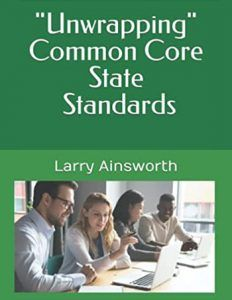How to Write Big Ideas & Essential Questions from “Unwrapped” Priority Standards
Date of Blog Post: March 15, 2022
Newly Republished on Amazon KDP! “Unwrapping” Common Core State Standards: Deconstructing Priority Standards to Identify Levels of Rigor, Big Ideas, and Essential Questions (Ainsworth, 2022)
Amazon Link to Book: https://tinyurl.com/yzs9mxwb
IMPORTANT NOTE TO READERS:
My newly republished book specifically addresses how to “unwrap” the Common Core State Standards in both English language arts and mathematics. The process educators use to “unwrap” their own state standards and write Big Ideas and Essential Questions in any grade, course, and content area, is directly relevant and applicable to ALL state standards—not to the Common Core only.
In addition to first seeing how to “unwrap” Priority Standards and identify related levels of thinking-skill rigor, you will learn how to:
- Determine Big Ideas (the aha’s or “lightbulb” moments of understanding) you want your students to discover as they learn the “unwrapped” standards.
- Write Essential Questions that engage students and lead them to their own discovery of the Big Ideas.
- BONUS: See 60 examples of “unwrapped” English language arts and math standards with Big Ideas and Essential Questions specific to K-2, 3-5, 6-8, and 9-12 grade bands!
The power of the “unwrapping” standards process–that includes how to write Big Ideas & Essential Questions–proven by educators and leaders in school systems across North America over the last 21 years, lies in the doing, in the experience of the process. As you fully engage in this simple-to-follow procedure, you will discover for yourself the truth of these words!
****************************************************************************
Determine the Big Ideas
Big Ideas are “light bulb moments,” those sudden flashes of illumination when a student says, “Oh, I get it!” and goes on to articulate the meaning he or she has suddenly come to understand.
Derived from the “unwrapped” Priority Standards, Big Ideas are the key understandings—the “aha’s” or “take aways” derived from the “unwrapped” Priority Standards—that you want your students to discover on their own by the end of a series of related lessons or an entire unit of study. Big Ideas convey to students the benefit or value of learning the standards in focus that they will remember long after instruction of those standards ends.
Big Ideas originate with the educator who thinks deeply, in advance of any instructional planning, about what the end learning goals for students should be for that particular instructional series or unit of study. The teacher then guides students to discover these Big Ideas for themselves through daily instruction and related learning activities. This “backwards planning” approach to standards-based, instruction-assessment design is an intentional way of aligning standards, assessment, curriculum, and instruction.
Topical Big Ideas—A Pathway to Broad Big Ideas (Excerpted from Book, pp. 67-68)
- Big Ideas can be topical (“Fractions represent quantities less than, equal to, or greater than one whole,” applicable to math only), broad (“People can justify their own conclusions with data,” applicable to several content areas), or both (“Objects can be compared and classified by their different attributes,” applicable to math and science).
- Topical Big Ideas relate primarily to a particular unit of study, a related series of lessons, or a section of the standards. The following topical Big Idea in reading is specific to standards that emphasize story elements and how they are arranged: “All events in a story—present, past, and future—play a strategic part in its conclusion.”
- Broad Big Ideas are the generalizations derived from one area of study that connect to many standards and even several subject matter areas, such as “Research brings together divergent viewpoints.”
Big Ideas—whether topical, broad, or both—help students scaffold their understanding so they can eventually make further generalizations and connections to other learning within a subject area and to other subject areas as well.
Create the Essential Questions
Essential Questions are engaging, open-ended questions that educators use to spark student interest in learning the content of a new unit of study or series of related lessons about to commence. Even though plainly worded, Essential Questions carry with them an underlying rigor. Responding to them in a way that demonstrates genuine understanding requires more than superficial thought.
Along with the “unwrapped” concepts and skills from the Priority Standards, educators use the Essential Questions throughout a series of related lessons or a unit of study to sharply focus curriculum, instruction, and assessment. Teachers pose open-ended Essential Questions at the beginning of the lessons or unit to engage students to discover for themselves the related Big Ideas.
The goal is for students to be able to respond to the teacher’s Essential Questions with corresponding Big Ideas stated in their own words! We know that what lasts is what we realize and conclude on our own. When students independently discover the Big Ideas for themselves (a discovery guided by their teacher), they are far more likely to retain those understandings long after instruction ends.
Attributes of Effective Questions (Excerpted from Book, p.83)
“Here are a few attributes or characteristics of effective questions to keep in mind when you and/or your colleagues are drafting and refining your own Essential Questions:
- Cannot be answered with a “yes” or “no”
- Have no single obvious right answer
- Cannot be answered from rote memory (simple recall of facts)
- Match the rigor of the “unwrapped” Priority Standard
- Go beyond who, what, when, and where to how and why”
Examples of Essential Questions with Corresponding Big Ideas
Big Ideas and Essential Questions can be generated from standards in all content areas and all grade levels. Here is a representative sample of Essential Questions with corresponding Big Ideas (in parentheses) from English Language Arts and mathematics.
English Language Arts:
- How can you convey a central idea when writing informative or explanatory texts? (You can convey or explain a central idea by supporting it with details and relevant content.)
- What makes a summary of informational text effective? (An effective summary of informational text is free of personal opinions and judgments.)
- How does an author of informational text convey a personal point of view? (You can convey or explain a central idea by supporting it with details and relevant content.)
Mathematics:
- How do I determine if my answer is reasonable? (Mental math and estimation strategies help me determine the reasonableness of an answer.)
- What kinds of strategies can you use when solving word problems? Why are they useful? (Diagrams, models, and equations help visualize and solve word problems.)
- Why learn math formulas and algorithms? How can they help us in real life? (The different math formulas, algorithms, strategies, and skills are all tools to simplify the problem-solving process.)
To see over 60 K-12 examples of how to “unwrap” Priority Standards with Big Ideas and Essential Questions, here again is the Amazon link to the book: https://tinyurl.com/yzs9mxwb
Thanks for reading! For more information about the “Unwrapping” Priority Standards, Big Ideas, & Essential Questions virtual workshop, please click on this link and/or email Larry at larry@larryainsworth.com.


